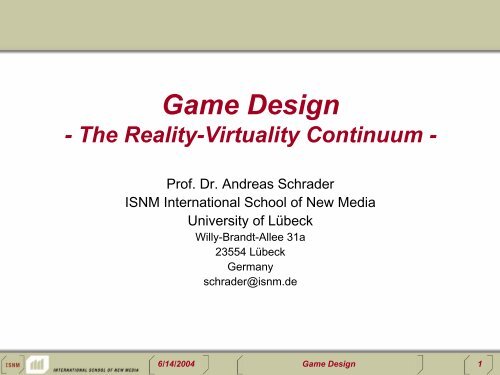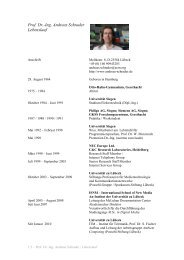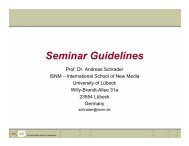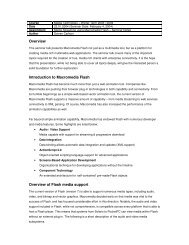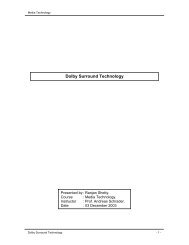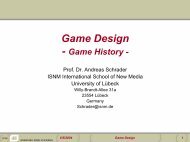Game Design - Andreas Schrader
Game Design - Andreas Schrader
Game Design - Andreas Schrader
You also want an ePaper? Increase the reach of your titles
YUMPU automatically turns print PDFs into web optimized ePapers that Google loves.
<strong>Game</strong> <strong>Design</strong>- The Reality-Virtuality Continuum -Prof. Dr. <strong>Andreas</strong> <strong>Schrader</strong>ISNM International School of New MediaUniversity of LübeckWilly-Brandt-Allee 31a23554 LübeckGermanyschrader@isnm.de6/14/2004 <strong>Game</strong> <strong>Design</strong>1
Mixed Reality The Reality-Virtuality ContinuumP. Milgram, H. Takemura, A. Utsumi, F. Kishino:Augmented Reality: A class of Displays on the Reality-Virtuality ContinuumSPIE Vol. 2351, Telemanipulator and Telepresence Technologies, 1994.RealEnvironmentVirtualEnvironment6/14/2004 <strong>Game</strong> <strong>Design</strong>2
Augmented Reality Goal: enhance the real worldsensation with useful information Users see real and virtualobjects Location-dependent additionalinformation can be provided(display menu cards forrestaurants) The real sensation can bepartially disabled (replace allbillboards with pictures fromlast holiday ...) Photo-realism not necessarilyfirst goal but in the ultimativesystem, people cannot decidewhether parts are virtual or realSource: http://www.csl.sony.co.jp/person/rekimoto/uist95/uist95.html6/14/2004 <strong>Game</strong> <strong>Design</strong>3
Mixed Reality Milgram‘s Taxonomy for mixed reality• Reproduction fidelity –quality of computer generated imagery• Extent of Presence Metaphor –level of immersion of the user within thedisplayed scene• Extent of World Knowledge –knowledge of relationships betweenframes of reference for the real world,the camera viewing it, and the userExtent of WorldKnowledgeExtent ofPresenceMetaphorReproductionFidelitySource: http://vered.rose.utoronto.ca/publication/1994/Milgram_Takemura_SPIE1994.pdf6/14/2004 <strong>Game</strong> <strong>Design</strong>4
Mixed Reality What do we need for the combination of read and virtual worlds?• Precise models• Locations and optical properties of the viewer (or camera) and the display• Calibration of all devices• Combination of all local coordinate systems centered on the devices andthe objects in the scene in a global coordinate system• Registration of models of all 3D object of interest with their counterpartsin the scene• Tracking of objects over time when the user moves and interacts withscene• Realistic merging requires:• Objects to behave in physicallyplausible manner when manipulated• Occlusion• Collision detection• Shadows• Detailed description of the physical sceneSource: Cindy Robertson (Georgia Tech)6/14/2004 <strong>Game</strong> <strong>Design</strong>5
Mixed Reality Components of a mixed reality systemSource: Cindy Robertson (Georgia Tech)6/14/2004 <strong>Game</strong> <strong>Design</strong>6
Mixed Reality Display Technologies• Monitor based• Simplest technique• Little feeling of beeing immersed in environmentSource: Cindy Robertson (Georgia Tech)6/14/2004 <strong>Game</strong> <strong>Design</strong>7
Augmented Reality Display Technologies• Head-Mounted-Displays• Main idea: enhance the human eye withartificial visual information super-imposed onreal light from the environment• Ian Sutherland started the development 1966• Many different technologies available• Applications are mainly in medical and militaryareas• Today you can buy HMD-displays in shops• A comprehensive market overview can befound at (http://www.stereo3d.com/hmd.htm)• Prices go from a few hundred to 100.000 €Ivan Sutherland 1966Cornegie Mellon University, 1995Source: PC Magazine, http://www-2.cs.cmu.edu/~wearable/navigator.html6/14/2004 <strong>Game</strong> <strong>Design</strong>Frog <strong>Design</strong> 20048
Mixed Reality Display Technologies• Optical see-through Head Mounted Display• Advantages:– Simple– No resolution limitations for real world picture• Disadvantages:– Delay for virtual image may cause offset in motions– Only bright objects can overpaint the reality, because ~30% of the realworlds image and ~70% of the virtual image can be seen in the displaysExample: Glasstron (Sony)Source: Cindy Robertson (Georgia Tech), http://www.vrealities.com/hmd.html6/14/2004 <strong>Game</strong> <strong>Design</strong>9
Mixed Reality Display Technologies• Optical see-through Head Mounted Display• Example: Nomad (Microvision)– SVGA 800x600 pixels– 20:1 @ 10-30° C– Monochrome redSource: http://www.microvision.com/nomad/index.html6/14/2004 <strong>Game</strong> <strong>Design</strong>10
Mixed Reality Steven Mann (MIT, now Toronto University)• Started to develop ‚Cyborg‘ equipment in school• Since the 1980s he is constantly warrying his ‚WearComp‘• His main research is for privacy and social impacts• He noticed two main trends:• The technology disminished (everthing moved into sunglasses)• His ‚Cyborg‘-feeling is growing over the yearsSource: http://www.eecg.toronto.edu/~mann/, http://wearcam.org/mann.html6/14/2004 <strong>Game</strong> <strong>Design</strong>11
Mixed Reality Example: aremac (EyeTap)• Used by Steve Mann• Mixes real and virtual light• Sensors are used to detectwhat the user sees• An augmented, diminished, orotherwise processed visualperception is presented to theuser with appropriate focaldistance and tonal range• Aremic visual results andenvironmental light havecollinear rays and appearspatially aligned in the user‘sfield of view (FOV)Source: http://eyetap.org/research/eyetap.html6/14/2004 <strong>Game</strong> <strong>Design</strong>12
Mixed Reality Example: Reality Window Manager (EyeTap)• Window manager for XWindows that overlays xterms and otherwindows onto planar patched in the environment• Allows for real-time tracking, replacement and renderingCommercial sign replaced by messageBillboard replaced by a web browserSource: http://eyetap.org/research/medr/rwm.html6/14/2004 <strong>Game</strong> <strong>Design</strong>13
Mixed Reality Display TechnologiesSource: http://www.microvision.com/nomad/index.html6/14/2004 <strong>Game</strong> <strong>Design</strong>14
Mixed Reality Display Technologies• Video see-through Head Mounted Display• Advantages:– No delay, since virtual and real images can be synchronized– Easy to control visual behavior like brightness or shadows– Virtual image can completely overpaint the real image• Disadvantages:– Delay between mechanical and seen motion can cause motion sickness– Real world image has the same (low) resolution as the display hasExample: COASTAR (Mixed Reality System Lab Inc.)Source: Cindy Robertson (Georgia Tech), http://citeseer.nj.nec.com/takagi00development.html6/14/2004 <strong>Game</strong> <strong>Design</strong>15
Mixed Reality Display Technologies• Projector-based• Advantages:– User is completely free of devices• Disadvantages:– User can be ‚in the way‘– Limited accuracy– Only one viewing directionUser(maybe head tracked)Real objects withretroflective coverageProjectorSource: http://www.cs.unc.edu/~debug/papers/DSLpaint/6/14/2004 <strong>Game</strong> <strong>Design</strong>16
Mixed Reality Display Technologies• Projector-based• Example: University of North Carolina at Chapel-HillRamesh Raskar, Greg Welch, Wei-Chao Chen.Table-Top Spatially-Augmented Reality:Bringing Physical Models to Lifewith Projected ImagerySecond International Workshop onAugmented Reality (IWAR'99),October 20-21, 1999, San Francisco, CA.D, Bandyopadhyay, R. Raska, H. Fuchs:Dynamic Shader Lamps:Painting on Real ObjectsThe Second IEEE and ACM InternationalSymposium on Augmented Reality (ISAR'01)New York, NY, October 29-30, 2001.Source: http://www.cs.unc.edu/~debug/papers/DSLpaint/, http://www.cs.unc.edu/~raskar/Office/index.html#pub6/14/2004 <strong>Game</strong> <strong>Design</strong>17
Mixed Reality Display Technologies• Projector-based• Example: Virtual Keyboard– LED projection of keyboard onto a flat surface– Infrared motion detectors sense movements of fingers– Also mouse and touchpad controlsSource: PC Magazine, http://www.ibizpda.com/6/14/2004 <strong>Game</strong> <strong>Design</strong>18
Mixed Reality Virtual Reality Technologies• CAVE• Projection based virtual reality system developed at the Electronic VisualizationLab of the University of Illinois at Chicago in 1992• A cave is a box of about 3x3x3 meters• One side is open (entrance), 8 walls are just as a projection space for 3-dimensional graphics (special shutter glasses are used for stereo effects)Source: http://www.aec.at/en/center/project.asp?iProjectID=11197, http://www.evl.uic.edu/pape/CAVE/6/14/2004 <strong>Game</strong> <strong>Design</strong>19
Mixed Reality Virtual Reality Technologies• CAVE• A magnetic emitter is positionedabove the CAVE.• The location of users aretracked by magnetic fieldsensors in the LCD glasses andin the ‚Wand‘ – a kind of 3Dmouse with a pressuresensitivejoystick• Graphics are projected to theleft and right eye alternatively at96 fps• The direction of the user’s viewis tracked by infrared detectorsWAND deviceSource: http://www.evl.uic.edu/pape/CAVE/LCD glasses6/14/2004 <strong>Game</strong> <strong>Design</strong>20
Mixed Reality Virtual Reality Technologies• CAVE• Advantages:– Allows for simultaneouslyusage by manyparticipants– Users do not need towear helmets• Disadvantages– Enormous effort incontrol hardware– Very expensive• You can visit one of thefew European CAVEs atthe Ars Electronica Centerin LinzSource: http://www.aec.at/en/center/project.asp?iProjectID=111976/14/2004 <strong>Game</strong> <strong>Design</strong>21
Augmented Reality Augmented Reality can be done with video ...• Example shopping or travel guidance systemsSource: http://www.howstuffworks.com/augmented-reality.htm6/14/2004 <strong>Game</strong> <strong>Design</strong>22
Augmented Reality ... and audio• But augmented audio is not always much appreciated ...Source: http://www.dilbert.com6/14/2004 <strong>Game</strong> <strong>Design</strong>23
Augmented Reality Example: Digital Desk (Wellner, Xerox, 1992)• Both electronic and paper documents have their advantagesP. Wellner: "DigitalDesk",Communications of the ACM, 36(7), pp. 87--96, July 1993.Also: http://www.xrce.xerox.com/competencies/image-processing/past-projects/history.html,http://citeseer.nj.nec.com/wellner93interacting.html6/14/2004 <strong>Game</strong> <strong>Design</strong>24
Augmented Reality Example: Digital Desk (Wellner, Xerox, 1992)• Extending the desktop methaphor to the real desk• Virtual (displayed) and real documents share the same spaceSource: http://www.xrce.xerox.com/competencies/image-processing/past-projects/history.html,6/14/2004 <strong>Game</strong> <strong>Design</strong>25
Augmented Reality Example: Digital Desk (Wellner, Xerox, 1992)• Allows for intuitive user patternsUser selects the text „4834“ on a sheet of paper,the system recognizes the text and displays theresult as an input for the virtual calculatoron the right side.DoubleDesk: The user is drawing on paper,while the system displays the remote playeras a virtual copy of the real action on the remotelocation. Both players have the same impression.Source: http://www.xrce.xerox.com/competencies/image-processing/past-projects/history.html,6/14/2004 <strong>Game</strong> <strong>Design</strong>26
Augmented Reality Example: Digital Desk (Wellner, Xerox, 1992)VideoSource: http://www.xrce.xerox.com/competencies/image-processing/past-projects/history.html,6/14/2004 <strong>Game</strong> <strong>Design</strong>27
Augmented Reality Example: Responsive Desk (GMD/Berkeley, 1997)• Combines the Digital Desk metaphor with 3D virtual reality• Computer-generated stereoscopic images are projected onto ahorizontal tabletop display surface via a projector-and-mirrors system• Scene is viewed through shutter glasses to generate the 3D effectSource: http://www.graphics.stanford.edu/projects/RWB/6/14/2004 <strong>Game</strong> <strong>Design</strong>28
Augmented Reality Augmented Reality in <strong>Game</strong> <strong>Design</strong>Source: http://www.infotech.oulu.fi/Annual/2000/VIRGIN.html6/14/2004 <strong>Game</strong> <strong>Design</strong>29
Augmented Reality Augmented Reality in <strong>Game</strong> <strong>Design</strong>• Example: PingPong Plus (MIT Tangible Media Lab)• Full-body motion in physical space with digital augmentation• Sound-based ball tracking technology• The ping pong game is augmented and transformed with dynamic graphics andsound, determined by the position of impact, and the rhythm and style of playIshii, H., Wisneski, C., Orbanes, J., Chun, B., and Paradiso, J.,PingPongPlus: <strong>Design</strong> of an Athletic-Tangible Interface for Computer-Supported Cooperative Playin Proceedings of Conference on Human Factors in Computing Systems (CHI '99),Pittsburgh, Pennsylvania USA, May 15-20, 1999, ACM Press, pp. 394-401.Source: http://tangible.media.mit.edu/projects/PingPongPlus/PingPongPlus.htmVideo at http://tangible.media.mit.edu/projects/PingPongPlus/mpeg_hires.mov6/14/2004 <strong>Game</strong> <strong>Design</strong>30
Augmented Reality Augmented Reality in <strong>Game</strong> <strong>Design</strong>• Example: Three Angry Men• (Interactive Media Technology Center,Atlanta and Augmented EnvironmentsLab, Georgia Institute of Technology)• AR version of the 20th century play„Twelve Angry Men“ (Reginald Rose)• Experiment to present a dramaticnarrative to experience the same storyfrom multiple points of view• The participants are in a physical ‚juryroom‘with 3 virtual characters(augmented videos through HMD)debate a trial on murder• Goal: dramatize the idea of differentpeople perceiving events differentlySource: http://www.imtc.gatech.edu/projects/technology/3angry.html, http://www.cc.gatech.edu/projects/ael/6/14/2004 <strong>Game</strong> <strong>Design</strong>31
Augmented Reality Augmented Reality in <strong>Game</strong> <strong>Design</strong>• Example: Three Angry Men• Participants can occupy theposition of each juror andtemporarily enter the character‘smind and hear the inner thoughts(location tracking technology)• Six minute scene is not perceivedlinearly but as a mixture of the threepoints of view• Each participant has a differentexperience depending on hermovementSource: http://www.imtc.gatech.edu/projects/technology/3angry.html, http://www.cc.gatech.edu/projects/ael/6/14/2004 <strong>Game</strong> <strong>Design</strong>32
Augmented Reality Augmented Reality in <strong>Game</strong> <strong>Design</strong>• Example: Virtual Moskity Hunting (Siemens)• <strong>Game</strong> on mobile phone SX1• Embedded camera shows real world• Virtual moskitos (mozzies) are superimposed• Players have to turn around the see all moskitos• Moskitos get killed by pressing the joystick button• 1 Minute timeAugmented RealitySoccer on PDASiemens C-LABhttp://mb5.net/images/game_design/images/praxissemester.pdfSources: http://www.siemens.com/index.jsp?sdc_p=t8c175suo1064046pnfl0m&sdc_sid=15545872840&6/14/2004 <strong>Game</strong> <strong>Design</strong>33
Augmented Reality Augmented Reality in <strong>Game</strong> <strong>Design</strong>• Example: Studierstube -Tangible Augmented Reality• (University of Vienna)• A combination of a tangible userinterface with augmented reality• Players see a 3-dimensionalgraphical presentation• Special interfaces allow for easymanipulation of objects• Several computer games havebeen implemented to test theconceptSources: http://www.cg.tuwien.ac.at/~cu/tangibleAR/6/14/2004 <strong>Game</strong> <strong>Design</strong>34
Augmented Reality Augmented Reality in <strong>Game</strong> <strong>Design</strong>• Example: Studierstube• More intuitive way of interactionbetween machine and users• Supports several players since it isnot restricted to a singlescreen/keyboard• Three-dimensional presentationincreases the realism of the game• Glass table with camera below avoidsocclusion of markers by users• Marker-based optical tracking• Virtual objects are placed on top ofthe markers• Only visible through HMD• Developed using the ARToolkitcameramarkerfor ARToolkitSources: http://www.cg.tuwien.ac.at/~cu/tangibleAR/6/14/2004 <strong>Game</strong> <strong>Design</strong>35
Augmented Reality Augmented Reality in <strong>Game</strong> <strong>Design</strong>• Example: StudierstubeSources: http://www.cg.tuwien.ac.at/~cu/tangibleAR/6/14/2004 <strong>Game</strong> <strong>Design</strong>36
Augmented Virtuality Augmented Virtuality: A complete virtual environment isaugmented with real object presentations• Avatars with real peoplefaces in virtual shops• Stills and videos of realobjects in virtual museums• Virtuality does not necessarilyrequires CAVE technologyKarl-Petter Akesson:Augmented Virtuality: A method to automatically augment virtual worldswith video images, Master Thesis, SICS, Sweden, 1996.Source: http://www.sics.se/~kalle/projects/Master_Thesis/index.html,http://vered.rose.utoronto.ca/publication/1994/Milgram_Takemura_SPIE1994.pdf6/14/2004 <strong>Game</strong> <strong>Design</strong>37
Augmented Virtuality Example: LeMo (Lebendiges virtuelles Museum Online)• VRML based web pages with real pictures of exhibition objectsarranged in the virtual spaceSource: www.dhm.de/lemo6/14/2004 <strong>Game</strong> <strong>Design</strong>38
Augmented Virtuality Commercial Applications• Manufacturing• Maintenance• Repair• Consumer andEngineering <strong>Design</strong>• Hazard Detection• (Tele-)Robotics• Medical• Military Training• Etc.AdvertisementSportsEntertainmentNewsSource: http://www.orad.tv/index.htm6/14/2004 <strong>Game</strong> <strong>Design</strong>39
Augmented Virtuality Augmented Virtuality in <strong>Game</strong> <strong>Design</strong>• Example: CamBall (VTT Information Technology – Multimedia Group)• Augmented virtual table tennis game• Internet/LAN based using real rackets• Only web camera is necessary• The camera image is streamed in real time• The rackets have paper stickers in greento detect player movements• Multicast version allows others to watch thegame onlineSource: http://www.vtt.fi/multimedia/index_iv.html, http://www.vtt.fi/multimedia/camball/camball.html6/14/2004 <strong>Game</strong> <strong>Design</strong>40
Augmented Virtuality Augmented Virtuality in <strong>Game</strong> <strong>Design</strong>• Example: AquaGauntlet TM• National Japan Research Project (1997-2001)• AquaGauntlet utilizes 3D mixed reality spaces• Video see-through HMD• Multi-player• Reflection of real world scenes onto virtual objects• Spatial sound effects• Gunshots and explosions are sensable physically through speaker vibrations• Gesture-based action commands• Opponent actions are visualized (gun fire, shields, etc.)Source: www.mr-system.com/project/aquagauntlet/, webster.fh-hagenberg.at/staff/haller/cgr2_20032004/09-Concepts-AugmentedReality.pdf6/14/2004 <strong>Game</strong> <strong>Design</strong>41
Augmented Virtuality Augmented Virtuality in <strong>Game</strong> <strong>Design</strong>• Example: Myst• Real person videos superimposed into virtual worldSource: http://www.mystrevelation.com,6/14/2004 <strong>Game</strong> <strong>Design</strong>42
Mixed Reality Mixed Reality in <strong>Game</strong> <strong>Design</strong>• Example: Gulliver‘s Box• Mixed Reality Lab of the National University of Singapore, the HumanInterface Lab of Osaka University’s Graduate School of EngineeringScience, the Ars Electronica Futurelab and Zaxel Systems Inc.Source: http://www.aec.at/en/center/project.asp?iProjectID=122866/14/2004 <strong>Game</strong> <strong>Design</strong>43
Mixed Reality Mixed Reality in <strong>Game</strong> <strong>Design</strong>• Example: Gulliver‘s Box• Recording Room• Visitors can record themselves (green screen effect)• A transparent box („Magic Cup“) as a tangible interface houses the figures fromthe recording room or other animated characters• Stage – The main playing space• Scenery can be decided• Characters can be placed by changing the position of the boxMagic CupRecording RoomStageSource: http://www.aec.at/en/center/project.asp?iProjectID=122866/14/2004 <strong>Game</strong> <strong>Design</strong>44
Mixed Reality Mixed Reality in <strong>Game</strong> <strong>Design</strong>• Example: Gulliver‘s Box• If two figures approach one another, they interact• The characters and recordings can be viewed on the stage using a HMD• The objects can be picked up, moved, set down, copied or erased usingthe magic cups – shaking changes the functionSource: http://www.aec.at/en/center/project.asp?iProjectID=122866/14/2004 <strong>Game</strong> <strong>Design</strong>45
Virtual Reality Virtual Reality – Should we replace our boring reality with amore exciting one?Source: Schmalstieg (University of Vienna)6/14/2004 <strong>Game</strong> <strong>Design</strong>46
Virtual Reality Virtual Reality tries for eliminating the reality Goal• Create a perfect aural, visual, and other media sensation such thatpeople forget the real environment and dive into another worldVirtual WeddingsVirtual Bungee Jumping6/14/2004 <strong>Game</strong> <strong>Design</strong>47
Virtual Reality Why?• Participants can join at distant locations• Physical limitations can be avoided• Dangerous situations can be trainedSource: http://www.aec.at/en/center/project.asp?iProjectID=12280Humphrey Flight Simulator, Ars Electronica Center, Linz, Austria6/14/2004 <strong>Game</strong> <strong>Design</strong>48
Virtual Reality Virtual Reality in Gaming• Example: <strong>Game</strong>s in the CAVE• CAVE Quake III Arena• Gladiator• CAVE Doom• Battalion• JacksSource: http://www.ncsa.uiuc.edu/VR/cavernus/shared.html6/14/2004 <strong>Game</strong> <strong>Design</strong>49
Virtual Reality Why not?• Expensive Equipment with complex setup• Usually many helping hand needed• Some people get sickThe R&R Virtual Reality ChairHumphrey Flight Simulator, Ars Electronica Center, Linz, Austria6/14/2004 <strong>Game</strong> <strong>Design</strong>50
Augmented Reality Useful Links• Columbia University• Computer Graphics and User Interfaces Labs• http://www1.cs.columbia.edu/graphics• The Georgia Institute of Technology• Augmented Environments Laboratory• http://www.cc.gatech.edu/projects/ael/• Sony• Augmented Reality and Computer Augmented Environmens Link Collection• http://www.csl.sony.co.jp/project/ar/ref.html• AR-PDA• German research project for AR on PDAs• http://www.ar-pda.com/• Christiane Ulbricht: Tangible Augmented Reality für Computerspiele• Diplomarbeit,• Technische Universität Wien, Institut für Softwaretechnik und interaktiveSysteme• 20026/14/2004 <strong>Game</strong> <strong>Design</strong>51


